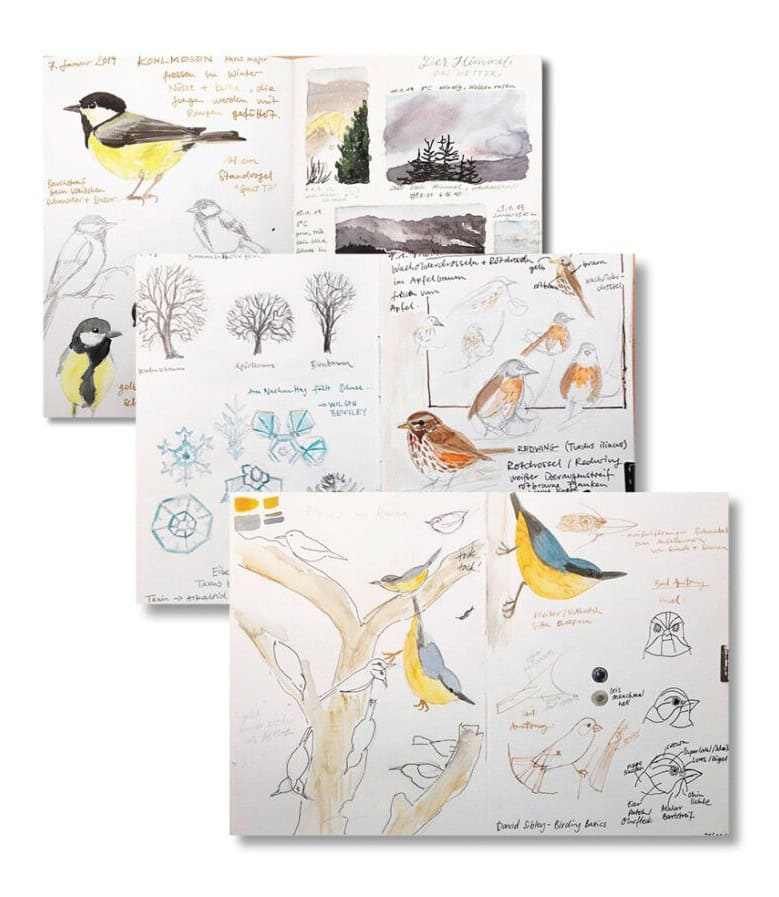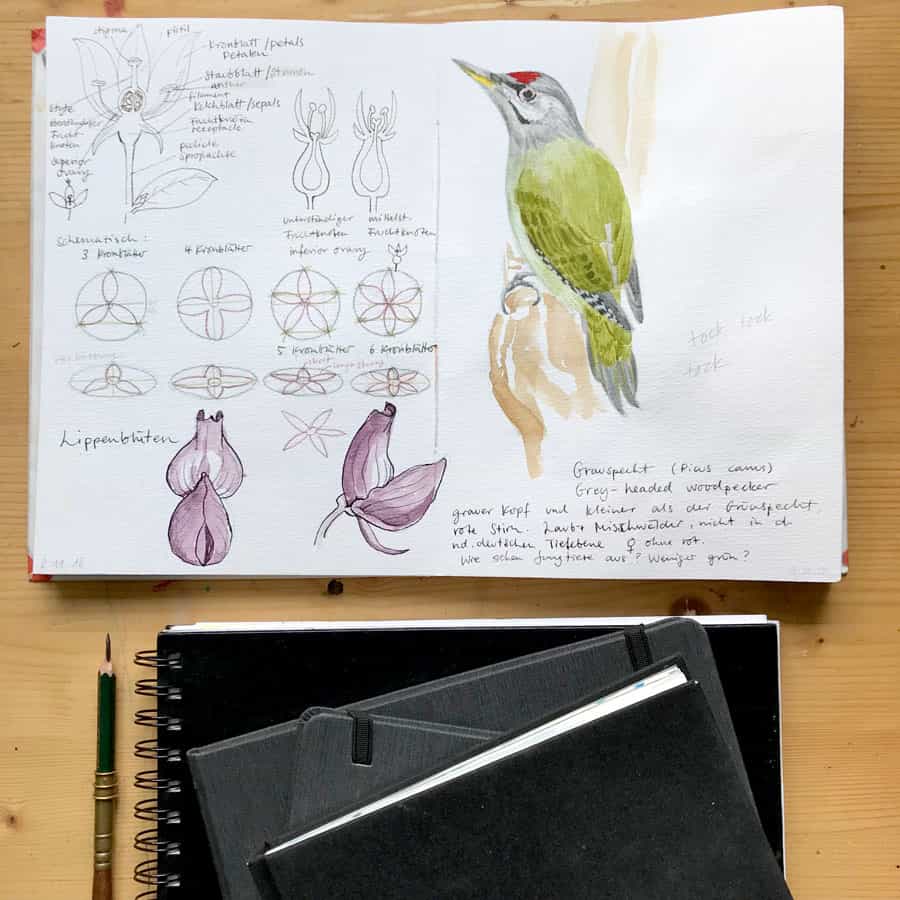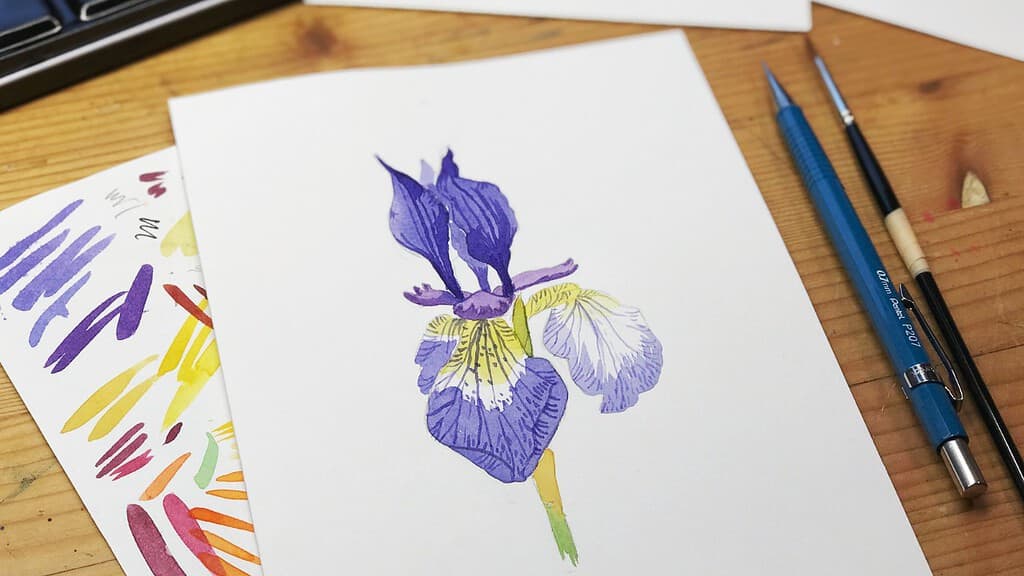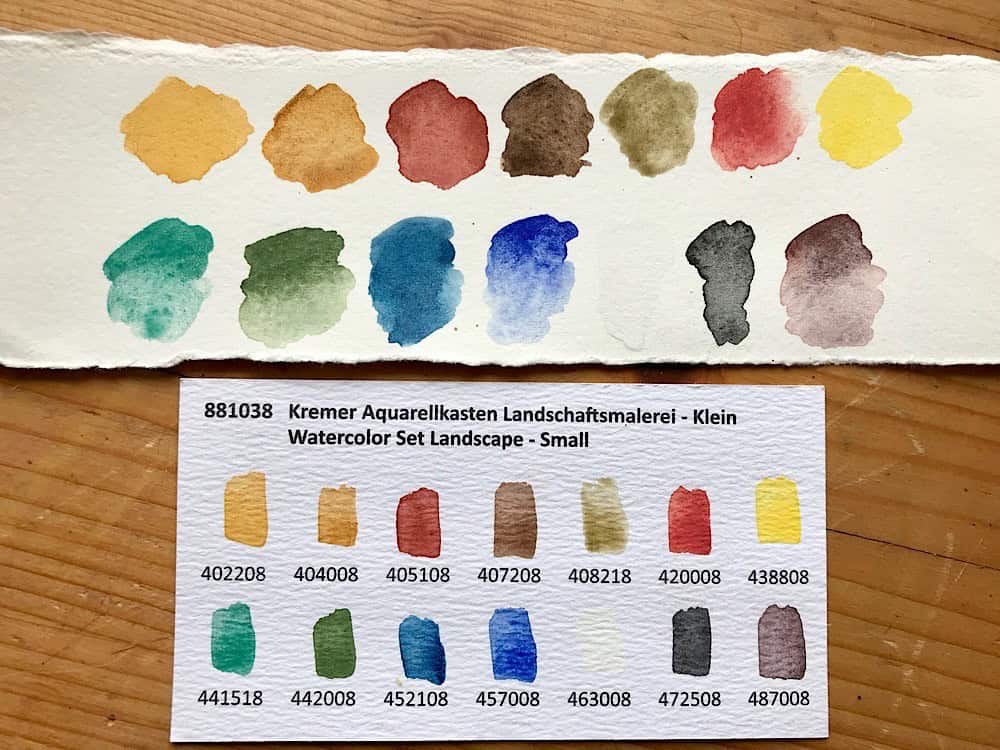I’ve written a long guide about choosing a sketchbook here, but I know some watercolorists prefer to work with loose paper at least for some subjects, or get their loose sheets made into sketchbooks. I even like to bind my sketchbooks myself so that I can choose the paper. There is a ton of different watercolor papers out there, and choosing amongst them can be stressful when you don’t know what to look for. Here are a few things I learned about watercolor paper over the years.
Get the best paper you can afford – should you really?
I often see this statement from experienced watercolorists: „You can save money on everything else, but not on the paper. Get cotton paper, even though it’s far more expensive.“ But is this really true? Yes and no. I have painted for years on (cheaper) cellulose paper and for sketchbook work, I would still tend to choose cellulose paper – basically because you rarely need the features of cotton paper in your sketchbook. But the right paper can make all the difference when you want to experiment with layering techniques or lifting and scrubbing, which won’t go well on inexpensive paper. There are basically two different kinds of paper, cellulose paper and cotton paper. While heavy cellulose papers usually work fine for loose and quick sketchbook work, cotton paper can take a lot more water and is recommended for more detailed paintings. That said, you can definitely make your first steps with cellulose-based papers – just expect a small learning curve when you switch to cotton paper, it can behave a bit differently. With all papers there can be huge differences in quality, so it’s usually best to avoid no-name papers or the art store brand. What I like to do is buy whole sheets and cut them down to the size I need, this is often more economic than buying pads. Note that pads and sheets from the same type of paper can also sometimes behave differently.
Cold-pressed and Hot-pressed paper – which is better?
Paper mills treat their paper differently, and the result are different surfaces. While cold-pressed paper still has a slight texture (bumps on the surface that you can see and feel), hot-pressed paper aims to be absolutely smooth. You would think that smoother paper works better for beginners, but usually that’s not the case. Since the paint can be harder to control on hot-pressed paper, it’s not what I would advise beginning watercolorists to get. If you don’t like heavily-textured paper (there are really rough papers out there, like Torchon paper), then choose a lightly-textured cold-pressed paper. The paint will flow a bit more easily than on hot-pressed paper and the paint will stay wet a bit longer.
Choose a paper with at least 300 gsm
The weight is another important factor. Don’t choose very thin paper, it will buckle and curl when you apply water. Choose a paper with at least 300 gsm. There are luxurious heavy papers with 600 gsm out there. Obviously, the more weight, the more expensive your paper, and the more you’ll have to carry with you.
More weight doesn’t mean better quality though, and if you have a thin, really well-performing paper, there’s no reason not to use it.
There’s a reason I have left out the pound measurement (lb) that’s used in North America. It can be slightly confusing (I know it was for me since I’m used to the metric system!), but 140 lb or 300 lb can’t simply be translated to gsm. Here’s the problem with that: gsm means gram per square meter – that’s an absolute measurement. You always know the weight you will get from your paper. Lb describes pounds per ream – but no-one has specified how much a ream is, it could be 500 sheets, but it doesn’t have to be. So with some manufacturers, these measurements aren’t comparable. You’d have to get really technical to figure out how the paper compares to another one by a different manufacturer with another ream size. And who really wants to do that? If you focus on the grams per square meter, you can compare papers directly, and I would recommend using the metric approach as a reference to choosing papers.
Usually, 300 gsm is about 140 lb, and 600 gsm is about 300 lb.
There is no front/back side or correct side to use on the paper
This may come as a surprise, since some manufacturers put watermarks into their paper to indicate a „correct“ side, and many discussions revolve around this. The front and back of watercolor papers can indeed be textured differently, or be treated with different sizing. That doesn’t mean you can’t use the other side if you prefer to work on it. There is no wrong side for paper, and in fact, if you work a lot in sketchbooks, you know very well that one can use both sides of a paper.
Use acid-free paper
This should go without saying, because most quality-papers will be acid-free anyway, but I still want to mention it. Do you remember these old paperback books from the library that have this yellow-brownish paper that crumbles when you look at it or barely touch it? That’s because the paper isn’t acid-free. This is usually the case for inexpensive wood-pulp (=cellulose) paper. This is why some artists never use any cellulose paper at all, because the risk of acidity and deteriorating paper is always there. If you use high-quality cotton paper, you won’t have this problem, but pay attention to get acid-free paper for your sketchbooks and your cellulose papers if you want to look at your sketches 20 years from now.
This is it for now! I hope these tips have been helpful to you. If there’s anything you’d like to add or ask, feel free to do so!
Thank you for reading this blog! It'll always stay free. To keep it going, you can support my work directly through a donation or through my nature sketching classes.

Join my free newsletter and never miss a blog post! You'll get new blog post notifications directly to your inbox. Receive 5 great sketching resources as a welcome gift for joining my newsletter! Here's what's inside:
- How to draw anything (PDF guide)
- Getting started with watercolor (free ebook)
- My favorite tips for creating great sketchbook pages
- My 5-step guide for drawing birds (PDF guide)
- My current watercolor palette layout (PDF guide)
By subscribing, you agree that I may process your information in accordance with my privacy policy





This is definitely the most concise and down to earth explanation of paper I have seen, thank you! You always do such a good job in making your thoughts accessible.
Thank you, I’m glad you got something out of the article! 🙂
Wow, this is the best article on paper I have read in a long time! Thank you for such complete yet down to earth explanation. And thank you for mentioning that cheaper paper is still ok in sketchbooks, that’s what I use and it’s just fine for nature journaling.
Have a great day!
Thanks Aneta, I’m glad you liked the post! Another advantage of more inexpensive paper is that you are more likely to actually do something with it instead of sitting in front of it and being afraid of ruining it – at least that’s my experience.